We spent our wedding-decenarry in Tuscany, Italy. Looking for something special on our anniversary date, I planned a visit to Massimo Bottura’s Osteria Francescana. Since we had been to Noma and El Cellar de Can Roca, it was also a logical addition to our bucket list in order to complete San Pellegrino’s TOP3. The outcome…well, interesting.
We went by car from Florence to Modena, which is quite a distance. Modena is a beautiful small city with a charming city center. Since we were too early for our lunch reservation we went for a walk in the pittoresque streets. Osteria Francescana is located on a corner in the backstreets of Modena:
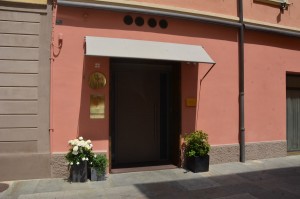
We entered the restaurant and got into a quite dark foyer. We seemed to be the first guests (and the only ones on time, hello Italy!) so we had to wait a minute or so until a waiter brought us to our table. The restaurant is remarkably small and also through daytime quite dark. The decoration and table setting tried to play a modern-retro game (straight lines, old photographies), which didn’t play out that well for me. After all it is a rather formal place and not as comfy as I would have expected.
On our way to the table in the corridor we passed by three stuffed pigeon sitting on a stick over a black sack of waste. Why not. As I’ve learned later, this was a reminder of Bottura’s visit to the 2011 Venice Biennale, where he saw Maurizio Catelans pigeon installation. He seemed to like the idea of pigeons looking down at all the art and shitting on it 🙂
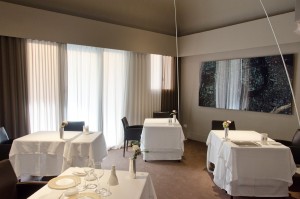
We decided to go for the classics menu (9 courses, € 165) which contains many of Massimo Bottura’s signature dishes. The sommelier who looked like a perfectly tailored figure out of a James Bond movie brought us the extensive wine menu. I decided to go with sparkling wine and he recommended a very nice bottle from a nearby region. Then we started our menu traditionally with bread and olive oil:
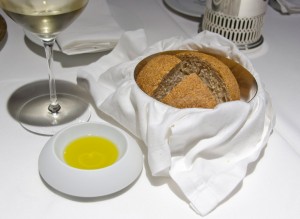
A rather rusty bread, very good and light oil.
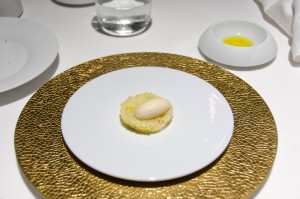
At first I thought this was a amuse bouche. But actually it was the first course. Inside the fluffy, savory tempura was a small aula fish (some kind of carp). This crunchy bite was topped with a rich ice cream of herbs, that added a nice texture contrast to this entrée. The name plays with the term „carpione“ that both refers to the species of the fish and to a marinade of herbs, wine and vinegar.
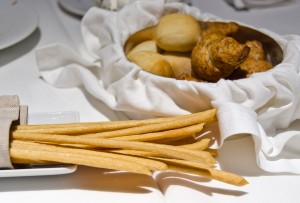
Then we were served bread again. As most mediterranean countries do, also Italiens like to have their bread near them while eating. It was a nice selection of small ciabatta breads, croissants and bread sticks. Since the menu itself was not very filling, the bread was a necessary addition. Soon we got the next course:

With this dish Massimo Buttura takes his guests on a double journey: it cites an eels travelling up the po river, bringing traditional products from along the river onto one plate. On the other hand it tells the story of the Este family, who had to move from Ferrara to modena in the 16th century. This dish brings a traditional product which is not very usual in haute cuisine – the eel – to the plate. The fatty, intense aroma of an eel is hard to deal with. In this case the eel was finished with saba (highly reduced must, the mother of aceto balsamico), giving it a sweet Japanese-style twist that countered the richness of the eel very nice. Up it had powder of burnt onion, that added some good depth. On the side it had a cream of green apple with a beautiful fresh acidity and some rich, creamy polenta. A very nice dish and maybe my personal highlight of this evening, since here the idea of connecting tradition, modernity, history and regionality worked out best and was communicated well.
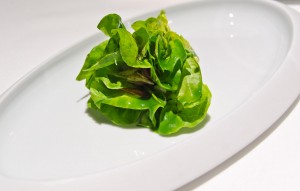
Next up was an international classic: A Caesar salad. An admittingly flawless heart of lettuce was presented with 22 different tiny ingredients hidden in it – containing all the different parts of a classic Caesar salad. I liked the idea, but after all it tasted like…well, salad. My wife went nuts for it, since she loves salad.
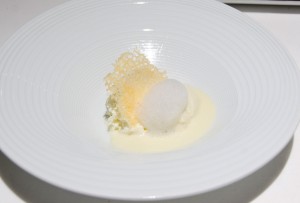
Then we had the maybe most recognized dish on Bottura’s menu. I have to admit that I love cheese and have a deep passion for Parmigiano. So this was just perfect for me 🙂 On the plate came a warm sauce (24 months), a cold and rather firm mousse (36), a soft demi-soufflé (30), a wafer (40) and a foam of 50 months old (!) Parmigiano Reggiano. You wouldn’t imagine how many different flavors Parmigiano can produce – from salty, over milky-sweet to nutty. It was a shere pleasure to wander through the different textures, temperatures and tastes. A very complex dish, that I will remember all my life.
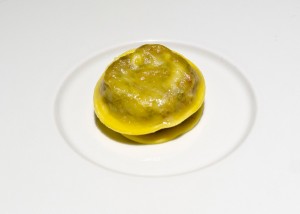
No italian meal without pasta. Contechino (a traditional pork sausage of modena) and lentils are a traditional winter dish (as we were told), usually eaten at New Year. But since they are so wonderful, Massimo Bottura loves to eat them all year long. Two wonderful ravioli with amazingly thin and perfectly firm-to-the-bite pasta, filled with lentils and fatty pork were presented. It was wonderful pasta, the one I would have loved to eat a whole plate of and maybe one of the best I have eaten so far.
In the meantime it also shows my problem with Bottura’s concept: If you have no memory of eating Contechino as a child, the dish’s concept is strange to you. Although the story is told by the waiters, you don’t feel it. Bottura is often recognized as enfant terrible of Italys kitchen. And he maybe is to those knowing Contechino as a traditional dish and wondering how you could change it into a pasta filling and then serving just 2 pieces of ravioli. But without this connection there is no scandal, no avantgarde – just good pasta. This evening I learned how difficult it is, to communicate feelings and ideas.
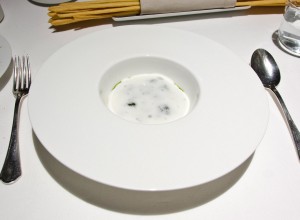
This was my least favorable dish of the day. The snails were enriched with earthy aromas of truffle, nuts and coffee and topped with raw potato cream and garlic foam. Not bad and well executed but also kind of banal.
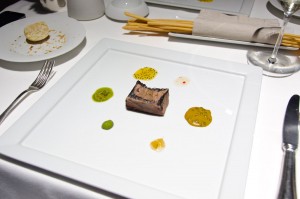
A very pleasant journey through the world: In the middle a tender piece of veal tongue with an aromatic crust, around it different sauces representing culinary cultures all around the world, including lentil/curry (India), Teriyaki (Japan), passion fruit with basil seeds (South America), a salsa verde with ciltrano (Mediterranean kitchen), leche de tigre (Peru) and a wild-apple mostarda (?). Good idea, very pleasant dish but not extraordinary.
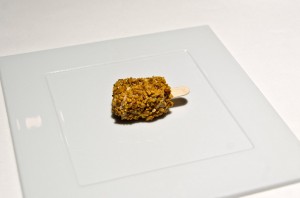
Another classic as pre-dessert, that was love at first glance: Since I love foie gras, nuts and Aceto Balsamico it was like heaven to find them in one bite together. The incredibly fine and buttery foie gras was covered with toasted hazelnuts and almonds. In it’s center a core of Traditional Balsamic Vinegar from Modena was injected. A wonderful variation on your childhood’s ice cream 🙂
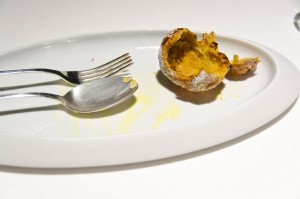
Evidentially I was still hungry, so I forgot to take a picture or the actual dessert. You can find on „The chic brûlée“ though. The dish bases on Bottura’s idea, that it is more honorable to be a potato than a truffle – so he put’s the potato in the center of this dessert. It basically consisted of a potato soufflé (concealed in it’s own skin), topped with vanilla cream and black truffle. Again it was good, but also kind everyday – a dessert your mother would make for you (without the truffle kick). Unfortunately the truffle was virtually tasteless and added not much to the dish.
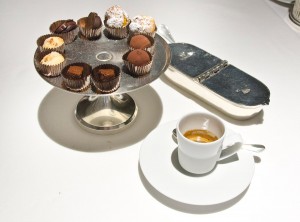
I finished my lunch with an espresso (good) and some petit fours (VERY good). When we left, the staff gave us a small bottle of balsamic vinegar (good quality, but of course not Aceto Balsamico Traditionale) as a present – a very nice gesture.
To be honest, when we left I was quite disappointed. Having heard about Bottura’s exceptionality I would have expected more. There were very memorable dishes (the eel, the Parmigiano, the lollipop) but also a lot of dishes that didn’t stay in my memory for long. Some months ago I saw a documentation on Netflix about Bottura, that helped me to understand him better. For sure he is a man full of inspiration, ideas. Pure avantgarde, an iconoclast who his up to smash tradtition and rebuild something new from it’s parts. As the pigeons in the corridor, his dishes are full of memories, endless variations an emotions. For some part he cooks like a postmodern artist (a good example for this is his variation of a ready-made: Oops! A broken lemon tart). His plates look like works of art. Like in modern art, the idea in many dishes seems to be more complex than the dish itself. Therefore some dishes are hardly accessible or seem banal (the Ceasar salad). In some dishes there was too much head and too few tongue. I suppose it is hard to communicate a whole set of ideas, feelings, memories, stories and history through a plate. For sure Bottura’s dishes would deserve something like a museum guide, that gives you the background to understand and fully appreciate them. If you plan on going to Osteria Francescana, make sure to watch a documentary on Bottura first – to have his manic passion and creativity in mind while eating.
Visit: Juy 2014
Michelin stars at time of visit: ***
Budget: 300€/person (including one bottle of wine)
Location: 7/10
Service: 7/10
Food: 7.5/10
